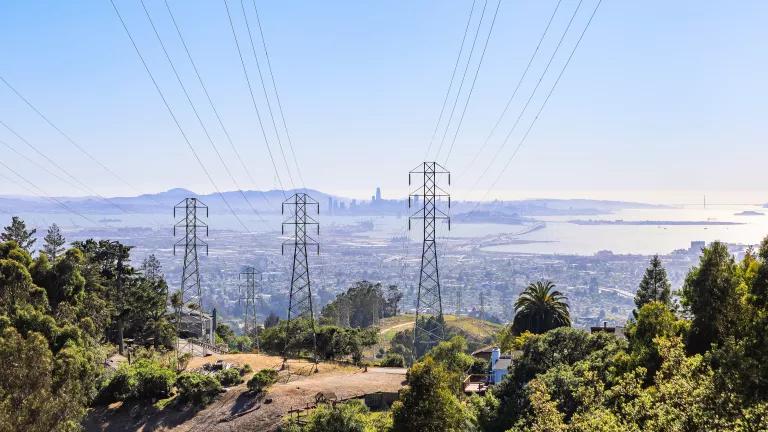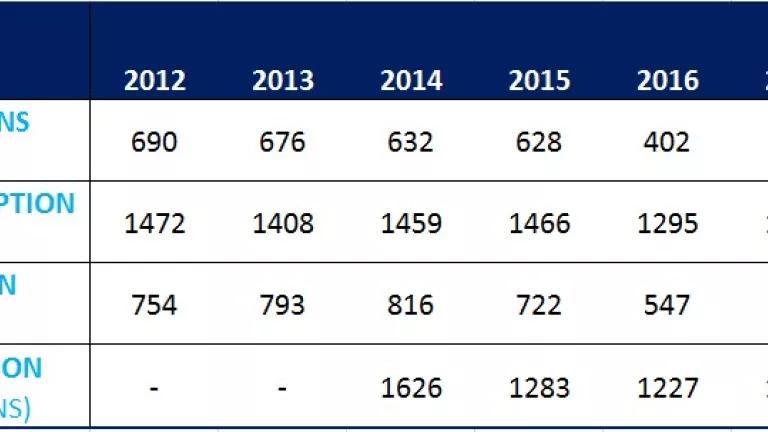California ISO Approves $7.3 Billion Investment in Transmission
Ambitious investment to boost transmission in support of clean energy is approved by the California Independent System Operator.

High voltage power lines and pylons on a hilltop overlooking San Francisco, California
Robert So
The 2022–2023 Transmission Plan from the California Independent System Operator (CAISO) proposes approval of $7.3 billion in investments in new and expanded electricity transmission capacity. This huge investment in new transmission capacity is needed to interconnect the vast array of new clean power generation and storage resources that are going to be built over the coming decade and to ensure that the electricity from those resources can be delivered to customers across the state to provide reliable and affordable power.
This transmission plan is an ambitious step forward. The $7.3 billion in new transmission infrastructure—which includes towers, wires, transformers, and substations—will go a long way toward connecting new renewable wind, solar, and geothermal resources in California and from across the western region. It will do so for less than 0.5 cents per kilowatt-hour (kWh) over the life of the projects, while significantly increasing our ability to deliver affordable clean electricity to Southern California. Most important, this increased capacity into Southern California will help reduce reliance on the aging fleet of fossil gas generation plants, which are used to meet peak demands, and will also reduce the threat of load shortages during extreme heat waves.
The plan is also notable for being more strategic, proactive, and closely coordinated with California’s energy agencies, the California Public Utilities Commission (CPUC) and the California Energy Commission (CEC), than past transmission plans. In recent years, the transmission plan was predicated on a laissez-faire, reactive approach in which the need for and location of new transmission was responsive to proposals of generation developers. In contrast, this year’s plan proactively identifies key transmission corridors that will be developed and anticipates prioritizing interconnection of new generation proximate to these lines, speeding development and lowering costs. This shift from reactive to proactive is critical to meet the historic build-out of clean energy resources.
While this plan is rightfully ambitious and its anticipated increase in investment is significant, more proactive investment will be needed in future transmission plans. The projected need for new clean resources will continue to rise beyond the 70 gigawatts (GW) of resources that the CPUC has already projected are needed by 2033, as vehicles and homes are electrified and dirty power plants in California and across the West are shuttered.
One area where more work is needed is the development of transmission to interconnect offshore wind (OSW) resources, an essential component to achieving California’s decarbonization goals. The 2022–2023 Transmission Plan acknowledges the importance of the OSW resource and identifies some of the challenges and opportunities, but largely defers approval of transmission solutions to the subsequent transmission planning cycle. Similarly, review of the Pacific Transmission Expansion Project, which would provide an undersea transmission link into Southern California, is also deferred, pending further discussions with the Los Angeles Department of Water and Power (LADWP).
We urge the CAISO to make OSW a key focus of next year’s transmission plan. In particular, we urge expeditious identification and approval of needed projects to interconnect and deliver OSW in future transmission plans to facilitate and support the further ramp-down of remaining fossil gas generation in the Los Angeles basin. Close coordination and collaboration with the CEC and CPUC, along with LADWP and other entities, will be key to the successful design and implementation of a solution.
A major challenge ahead is how to bring these new transmission investments online expeditiously while protecting vulnerable communities and sensitive habitats. Transmission is often talked about in tandem with development challenges, like siting and permitting processes that can stretch from years to decades, frustrating even the most tenacious developers. We must optimize the approval process to bring more facilities into service faster in order to achieve the clean energy economy we’re striving for. The Memorandum of Understanding on transmission between the three lead entities is a good start in that direction, but much more needs to be done. Regulatory and legislative improvements will both be needed, and California’s Senate Bill 420 is an earnest attempt to do just that.
Transmission facilities include major power lines, running for many miles, and large substations, both of which often pass through or are located in communities and valuable habitats. The challenge we face is expediting the permitting and siting process while ensuring the protection of human and environmental health. Overcoming this challenge will require robust cooperation among state agencies and between jurisdictions, as well as a willingness to achieve reasonable compromise among developers and advocates.
Falling short of meeting this challenge will delay the pace at which we can transform our energy grid and eliminate greenhouse gas emissions, preventing cost reductions and enhanced protections for vulnerable communities.




